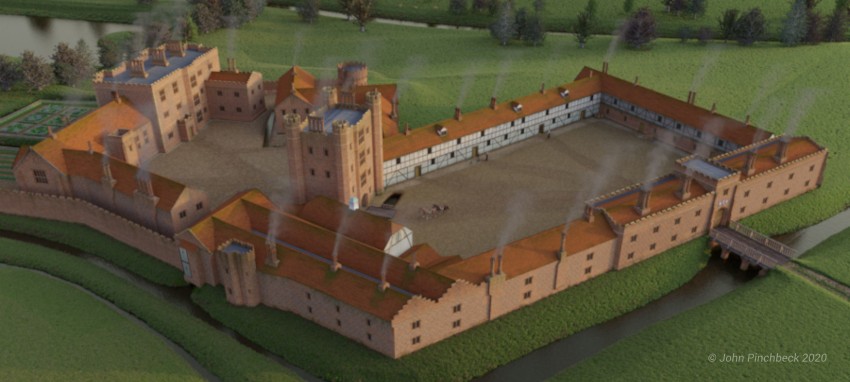Elsyng Palace

Following Lovell's death in 1524, the palace passed into the hands of the Earl of Rutland, but was eventually acquired by Henry VIII in late 1539, who quickly set about upgrading it to a fully fledged royal residence, one of several that were intended mainly for the use of his children, especially his young son Edward.
Subsequent monarchs had difficulty mantaining the large collection of properties Henry had built up during his lifetime, and despite periodic efforts at rennovation Elsyng fell into disrepair and disuse and was ultimately sold off by Charles I in 1641, as he prepared for the increasingly inevitable English Civil War.
What remained of the palace was held by the Earl of Pembroke up until his death in 1650 and at some point soon after the estate was purchased by Nicholas Rainton, whose adjacent house, Forty Hall, had been built by his great uncle (also Nicholas) in 1629.
Archaeological evidence points to a brief attempt at farming the site before it was eventually cleared and landscaped, ending with the creation of the pleasure grounds including raised walks and the lime tree avenue that can be seen today.
The site lay largely forgotten in the grounds of Forty Hall, until it was bought by Enfield Council in 1953 and subsequently opened as a public park.
The EAS led a series of excavations between 1963 and 1966 which reestablished the palace's location, and revealed its exceptional archaeological preservation below ground level. Recognising the site's historical significance and unique archaeological potential, the government designated the site a Scheduled Ancient Monument in 1967 and there followed a 37-year moratorium on excavation.
Despite the Society's work in the 1960s and extensive desktop and non-invasive studies in the following years, the site was poory understood and many questions remained about its layout and preservation, and so in 2004 the EAS began a new programme of research in cooperation with Historic England (then English Heritage) and Enfield Council.
We now understand much more about the site and its history, and have recently published a detailed account of our excavations between 2004 and 2019 including a comprehensive survey of all the available documentary evidence, in our book Monarchs Courtiers and Technocrats.
The book was partly funded by the Stories of Enfield project, which also produced a video during our summer dig of 2022 - see below.
The remains of Elsyng Palace lie towards the end of Forty Hall's lime tree avenue. The avenue was created close to the turn of the 18th century as part of a programme of landscaping following the final demolition of the palace, and roughly bisects the site of the palace's outer courtyard.
The inner courtyard was located to the west of the avenue in what is now increasingly dense woodland.
Although nothing remains today of the palace above ground, the woodland conceals evidence of the former royal residence in the form of banks, ditches and terraces. The ponds and lakes to the north-west of the avenue may also be relics of fish ponds which once served the royal kitchens.
The park is a Scheduled Ancient Monument - unauthorized excavation and metal detecting is a criminal offence.
A short film about our 2022 annual excavation on the site of Elsyng, Enfield's lost Tudor Palace in the grounds of Forty Hall, made by Footpath Films and funded by The National Lottery Heritage fund as part of the Stories of Enfield project.
As part of our research for our recent publication on the palace, Monarchs Courtiers and Technocrats, we pulled together for the first time all the available contemporary documentary sources, including wills, inventories and household accounts.
Transcriptions of these are available in the appendices of the book, and some selected transcriptions are also available to read below:
 The Will of Sir Thomas Lovell, K.G.
The Will of Sir Thomas Lovell, K.G.
 The Inventory of Sir Thomas Lovell, K.G.
The Inventory of Sir Thomas Lovell, K.G.
 Expenses of James Nedham, Surveyor of the King's Works, 1540
Expenses of James Nedham, Surveyor of the King's Works, 1540